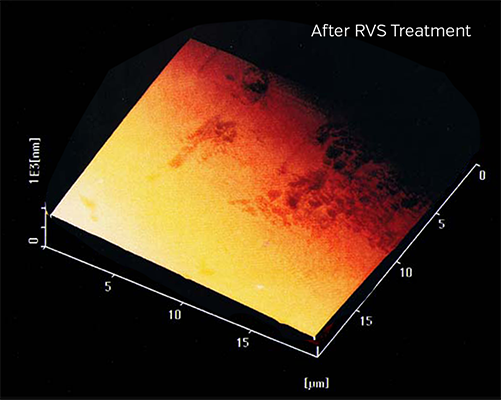RVS Technology treatments lasts at least 60,000 miles per treatment!
RVS Technology integrates with the original surface creating a mirror-like Triboceramic surface on the friction zones of mechanisms. As a result a worn mechanism is restored to near or original specification due to friction decreasing with tolerances and compression restoring to, or close to original specification.

Add half of the RVS mixture to a warm engine

Let your engine idle for 15 minutes
Add remaining RVS mixture and drive for 30 minutes
BREAKING DOWN FRICTION
Building new material, not polishing! RVS Technology treatment grows new surface material to all those friction surfaces that are in contact with the oil. The metal ceramic surface is formed only in the areas in which there is friction and the abrasion occurs only in those areas where the surface has breaking peaks in the surface. In addition, the new surface created is much harder and smoother than the original. Seen here is a laser microscope image of a camshaft before and after RVS Technology treatment.


FREQUENTLY ASKED QUESTIONS
RVS Technology® Tribo(nano-)Ceramics can be considered as an advanced mode of cure for engines, gearboxes, and other mechanisms. If your device has normal wear problems like noise, smoking, too high consumption of oil or fuel, decrease of power and compression level, unbalance and vibrations RVS Technology has the capacity to restore it.
RVS Technology works also as a preventive method, protecting your mechanisms against coming wear. For example treatment of car parts will protect your car from serious problems in the future.
Restores Vital Surfaces
No! Unlike oil additives on the market, RVS Technology® products produce a nano-ceramic layer that integrates with the metal friction surfaces of your engine, transmission, differential etc. That’s why it lasts at least 60,000 miles (or 2500 hours in machinery) and oil changes do not affect it. RVS does not affect the properties of oil. The idea of oil additives is to improve the oil’s properties and have to be re-applied at every oil change.
“I performed RVS engine treatments to my 2002 Audi S4 and 2013 Mustang GT. Both cars ran smoother and quieter (especially the Audi with higher mileage). Even the Mustang with only 30k miles picked up an average fuel economy improvement of 2mpg!”
I have been using RVS Technology for about 3 years now. I have used it on Class 8 Engines and Transmissions. My experience has been nothing but the best. I am currently driving a 2012 Peterbilt 386 Cummins ISX 12 with 975,000 miles and Running Extremely Strong. I asked an affiliate what was the most mileage he has seen on a class 8 engine with RVS Technology and he replied 3 million plus miles…WOW…If you are serious about your business you need to secure your most valuable asset (your engine) Stop wasting your money on additives and protect all your engine and transmission components with RVS Technology…You’ll feel the difference right away…
I highly recommend the RVS oil treatment for anyone wanting to extend the life of their car. Around 2016 I acquired an SUV with high mileage that I really only needed, I thought, for a couple years. But, as sometimes happens, fate had different plans for me. Fortunately, while readying the car for a couple years of road travel, I came across an article about RVS and how this technology, used on high pressure, high friction large machines, increased the functional life cycle and productivity of the equipment. As I recall, the treatment would be good for about 60,000 miles, or 30,000 more miles than I thought I needed. Today, after 7 1/2 years and 100,000 miles driven, that old engine still purrs like a kitten.
My 2010 5.4L F150 @ 128k starting to get that power steering wine that typically indicates that sometime in the future you’ll be replacing it. Well I added this stuff and within 50 miles it sounded normal! It’s been about a thousand miles now and still sounds like it did when it was new. The product send to work as advertised.
“I have a Hybrid Jetta with 19k miles and I put RVS T6A treatment to the DSG gearbox and after driving 300 km I’ve noticed a 5% increase in MPG in highway driving. Also the gearbox is acting much more smoothly than before.”
“I performed an RVS treatment to my car’s engine that has 230,000km (145k miles) and I am beyond thrilled! I already thought about replacing my hydraulic valve train, but after the treatment, their sound and vibration disappeared. At the same time, the torque down low in the power band increased noticeably and the engine idling became smoother”